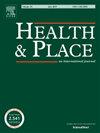邻里肥胖与荷兰成年人体重状况之间关系的调节因素和中介因素。
IF 3.8
2区 医学
Q1 PUBLIC, ENVIRONMENTAL & OCCUPATIONAL HEALTH
引用次数: 0
摘要
本研究旨在评估荷兰成年人的社会人口、个性和心理调节因素以及生活方式行为调节因素与邻里肥胖和体重状况之间的关系。这项横断面研究使用了生命线研究中 150,506 名成年参与者的基线数据。为了量化荷兰居民区的致肥性,研究人员使用了 "致肥建筑环境特征(OBCT)指数",该指数是在参与者居住地周围 1000 米的圆形缓冲区内计算得出的。食物和体育锻炼(PA)环境各组成部分的 Z 值取平均值,并在 0 到 100 之间进行重置。体重状况以客观测量的腰围为准。当交互项显著时,按(自我报告的)社会人口因素、感知压力、冲动、自律和深思熟虑进行分层线性回归分析(P本文章由计算机程序翻译,如有差异,请以英文原文为准。
Moderators and mediators of the association between the obesogenicity of neighbourhoods and weight status in Dutch adults
This study aimed to assess sociodemographic, personality, and psychological moderators, and lifestyle behavioural mediators, of the association between obesogenicity of neighbourhoods and weight status in Dutch adults. This cross-sectional study used baseline data of 150,506 adult participants of the Lifelines study. To quantify obesogenicity of Dutch neighbourhoods, the Obesogenic Built Environment CharacterisTics (OBCT) index was used, calculated for 1000 m circular buffers around participant's residencies. Z-scores of components across food and physical activity (PA) environments were averaged, and rescaled from 0 to 100. Weight status was operationalised as objectively measured waist circumference. Stratified linear regression analyses by (self-reported) sociodemographic factors, perceived stress, impulsivity, self-discipline, and deliberation were conducted when interaction terms were significant (P < .01). Mediation by adherence to the Dutch PA guidelines and dietary behaviour was examined using the difference-in-coefficients approach. Every 10% increase in OBCT index was associated with a 0.65 (P < .001, 95%CI [0.59, 0.71]) centimetre larger waist circumference. The association was largest for respondents who were younger, had the lowest income, the highest educational level, the least self-discipline, the highest impulsivity scores and the most perceived stress. Adherence to PA guidelines and dietary behaviour mediated 13.3% of this association; however, the difference in coefficients was not statistically significant. Our findings enable to better target lifestyle interventions to individuals most vulnerable to obesogenic environments. Furthermore, they provide guidance for policymakers and urban planners in promoting health-enhancing environments.
求助全文
通过发布文献求助,成功后即可免费获取论文全文。
去求助
来源期刊

Health & Place
PUBLIC, ENVIRONMENTAL & OCCUPATIONAL HEALTH-
CiteScore
7.70
自引率
6.20%
发文量
176
审稿时长
29 days
期刊介绍:
he journal is an interdisciplinary journal dedicated to the study of all aspects of health and health care in which place or location matters.
 求助内容:
求助内容: 应助结果提醒方式:
应助结果提醒方式:


